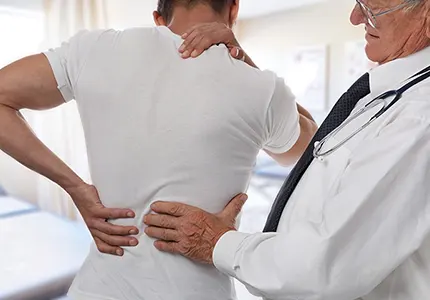- Herniated Disc
- Nerve Pain
- Lower Back Pain
- Abdominal Pain
- Neck Pain
- Sciatica
- Spinal Stenosis
- Pinched Nerve
- Neuropathy
- Joint Pain
- Complex Regional Pain Syndrome
- Facet Joint Pain
- Facet Syndrome
- Spinal Arthritis
- Degenerative Disc Disease
- Fibromyalgia
- Myofascial Pain Syndrome
- Phantom Limb Pain
- Cancer Pain
- Headaches and Migraines
Service Reviews
- C.A. / Google
"Pain management is absolutely a difficult Tight rope. I don't want to become addicted to drugs but I also don't want spinal surgery. Doctor Murphy and PA Eason are working with me for a healthy balance. In office procedures that alleviate pain and enough of the RIGHT meds to be able to function in a healthy way and continue working. I have been a patient here for quite some time and they are working with my insurance as well as me to ensure a seamless program for me for 2022!"
What is a Spinal stenosis?
Spinal stenosis is narrowing in the spine that can be in the central canal, where the spinal cord is located, or where the nerve roots exit from the spinal cord, the neuroforamen. This is most commonly due to degenerative changes such as disc bulges or enlargement of the facet joints from arthritis, bone spurs, thickened ligamentum flavum (ligament that runs in between the vertebrae and spinal cord providing strength to the spine). Symptoms can include pain and/or numbness in the neck with possible radiation into the arms, weakness, numbness, and if severe enough, can cause bladder and bowel difficulty. The pain is worse with activity such as working with the upper extremities, driving, or working over a desk or computer. Treatment options include oral steroids, anti-inflammatory medications like Ibuprofen or Naproxen, anti-seizure medications, pain medications, physical therapy, and epidural steroid injections. In some patients, surgery to open the space is necessary or indicated.
Lumbar spinal stenosis is a disorder that causes nerve and spinal cord impingement as a result of the narrowing of the spinal canal. While some individuals suffering from spinal stenosis do not exhibit any symptoms, others may notice a tingling sensation, as well as muscle weakness, pain, and numbness. Frequently caused by changes in the spine due to osteoarthritis, spinal stenosis may need to be treated with a surgical approach, depending on the severity of the case. There are two main types of spinal stenosis: cervical stenosis and lumbar stenosis. Your treatment options offered at Tricity Pain Associates at our Texas locations may vary, depending on the exact type and cause of your spinal condition. Our skilled team of physicians will work with you to evaluate your symptoms and determine the best course of treatment for your specific case. Contact us today to learn more and to schedule your initial consultation with our experienced physicians.

Symptoms of a Spinal Stenosis
Several symptoms can be associated with spinal stenosis, including:
- Numbness in the hand, foot, leg, or arm (for both cervical and lumbar stenosis)
- Neck pain (cervical)
- Leg pain (lumbar)
- Weakness in a hand, arm, foot, or leg (cervical)
- Weakness in a foot or leg (lumbar)
- Cramping or discomfort in one or both legs, which occurs when standing for a long time or when walking (typically diminishes when you sit or lean forward) (lumbar)
- Bowel or bladder dysfunction (for severe cases of cervical stenosis)
What Causes Spinal Stenosis?
Extending from the neck to the lower back, the bones of your spine are what create the spinal canal. This canal acts as a defense for your spinal cord and nerves. Though some individuals could be born with a small spinal canal, spinal stenosis often occurs in instances when open space exists in the spine. The most common causes of spinal stenosis can include the following:
- An injury or trauma to the spine: Vehicular accidents and additional trauma can lead to fractures or dislocations of vertebrae. It may harm the internal structures of the spinal canal, and the swelling of tissue around it can also place pressure on the nerves.
- Bone overgrowth: The natural wearing on your spinal bones can wreak havoc on your spinal canal, triggering the development of bone spurs.
- A tumor: Growths can form inside the membranes that protect the spinal cord or in the space between it.
People at the age of 50 and above are most likely the ones suffering from spinal stenosis. However, certain factors can lead to spinal stenosis in younger people, including trauma, scoliosis, and a genetic disorder.
Treatment for spinal stenosis
Treatment for spinal stenosis will vary, depending on the severity of your condition but could range from medication to more invasive techniques. During your initial consultation, one of our certified pain management specialists will perform imaging tests to help identify the cause and type of spinal stenosis. An appropriate treatment plan will then be created for your specific needs. This may include medication therapy, physical therapy, steroid injections, or a percutaneous disc decompression. In a decompression procedure, an area of ligament is removed from the spinal column with a needle-like instrument to create more room within the spinal canal. After providing any form of treatment, our pain management team will offer you any necessary aftercare instructions to ensure the best possible results.
Learn More
At Tricity Pain Associates, we work to create more comfortable lives for all of our Texas area patients. Through innovative treatment options, you can experience advanced relief from spinal stenosis symptoms. We invite you to contact one of our Texas pain management locations to learn more and to schedule your initial consultation.
